NVIDIA GeForce GTX 770 Review: The $400 Fight
by Ryan Smith on May 30, 2013 9:00 AM ESTAlthough GTX 770 is already a very high clocked part for GK104, we still wanted to put it through its paces when it comes to overclocking. Of particular interest here is actually memory overclocking, as this is the first video card shipping with 7GHz GDDR5 standard. This will let us poke at things to see just how far both the RAM itself and NVIDIA’s memory controller can go.
Meanwhile the switch to GPU Boost 2.0 for GTX 770 is going to change the overclocking process somewhat compared to GTX 680 and GTX 670. Overvolting introduces marginally higher voltages and boost bins to play with, while on the other hand the removal of power targets in favor of TDP means that we only get 106% – an extra 14W – to play with in TDP limited scenarios. Thankfully as we’ve seen we’re generally not TDP limited on GTX 770 at stock, which means our effective headroom should be greater than that.
| GeForce GTX 770 Overclocking | ||||
| Stock | Overclocked | |||
| Core Clock | 1046MHz | 1146MHz | ||
| Boost Clock | 1085MHz | 1185MHz | ||
| Max Boost Clock | 1136MHz | 1241MHz | ||
| Memory Clock | 7GHz | 8GHz | ||
| Max Voltage | 1.2 | 1.212v | ||
We’re actually a bit surprised we were able to get another 100MHz out of the GPU itself. Even without the extra overvoltage boost bin, we’re still pushing 1200MHz+ on 1.2v, which is doing rather well for GK104. Of course this is only a 9% increase in the GPU clockspeed, which is going to pale in comparison to parts like GTX 670 and GTX 780, each of which can do 20%+ due to their lower clockspeeds. So there’s some overclocking headroom in GTX 770, but as to be expected it's not a lot.
More interesting however is the memory overclock. We’ve been able to put another 1GHz on 6GHz GTX 680 cards in the past, and with the 7GHz base GTX 770 we’ve been able to pull off a similar overclock, pushing our GTX 770 to an 8GHz memory clock. The fact that NVIDIA’s memory controller can pull this off is nothing short of impressive; we had expected there to be some headroom, but another 14% is beyond our expectations. At this clockspeed the GTX 770 has a full 256GB/sec of memory bandwidth, 33% more than both a stock GTX 680 and the 384-bit GTX 580. Of course we’ll see if GTX 770 can put that bandwidth to good use.
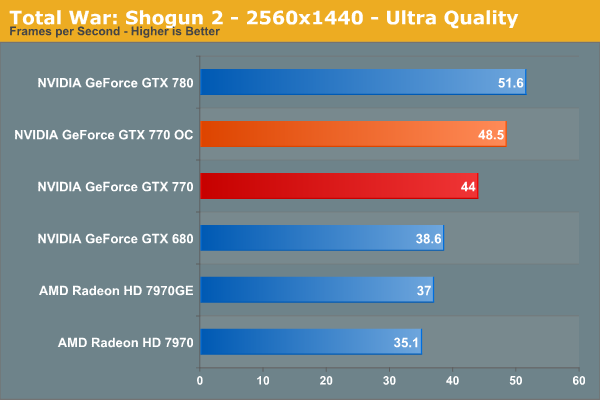
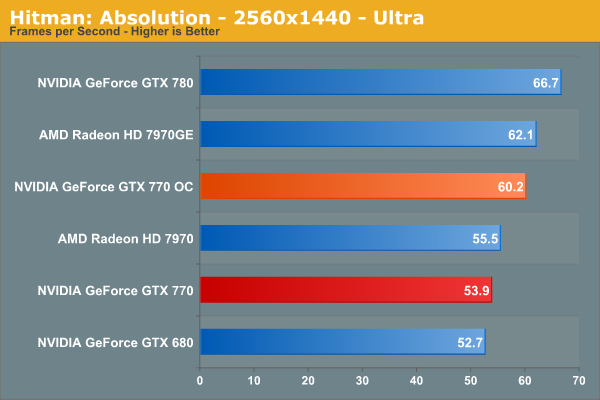
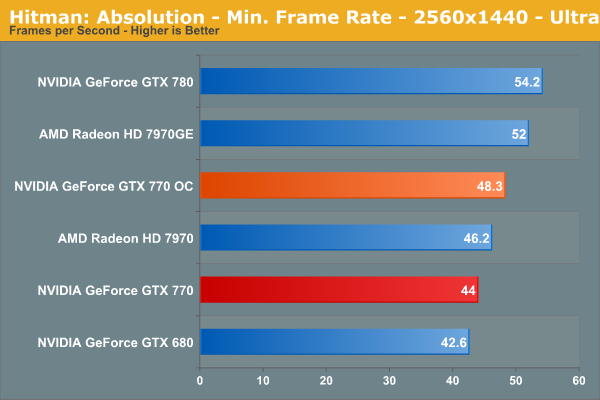
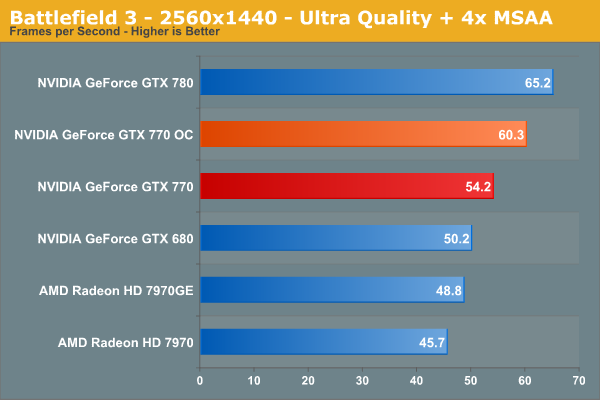
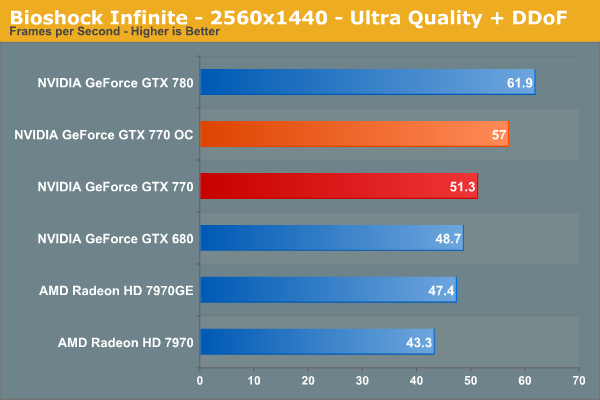
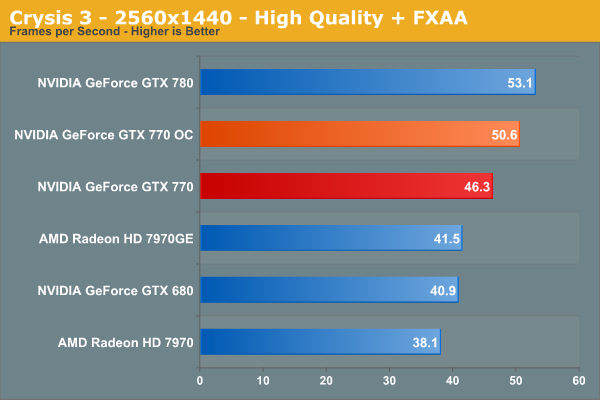
The end result of our overclocking efforts nets a very consistent 9%-12% increase in performance across our games. 9% is the upper bound for improvements due to GPU overclocking, so anything past that means we’re also benefitting from the extra memory bandwidth. We aren’t picking up a ton of performance from memory bandwidth as far as we can tell, but it does pay off and is worth pursuing, even with the GTX 770’s base memory clock of 7GHz.
Overall overclocking can help close the gap between the GTX 770 and 7970GE in some games, and extend it in others. But 10% won’t completely close the gap on the GTX 780; at best it can halve it. GTX 780’s stock performance is simply not attainable without the much more powerful GK110 GPU.
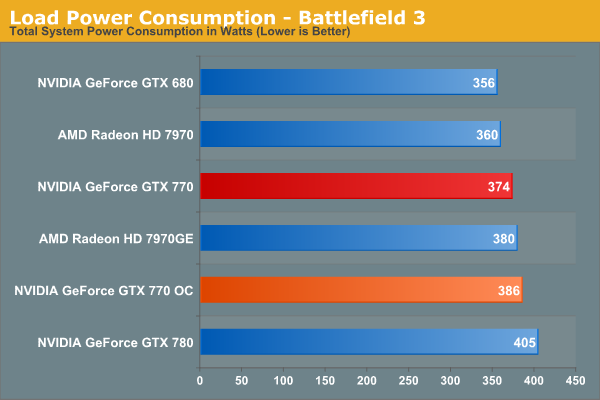
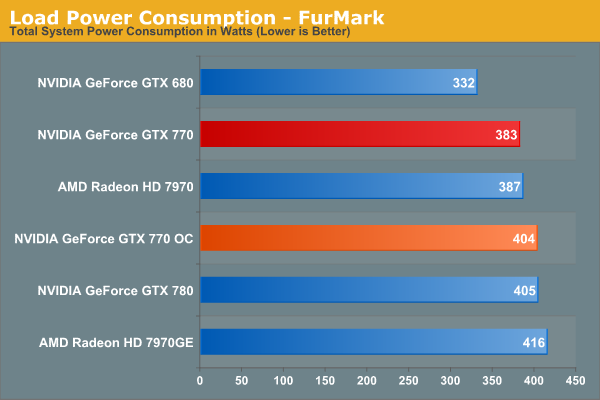
Moving on to power consumption, we can see that the 106% TDP limit keeps power usage from jumping up by too much. In Battlefield 3 this is a further 12W at the wall, and 21W at the wall with FurMark. In games this means our power usage at the wall is still below GTX 780, though we’ve equaled it under FurMark.
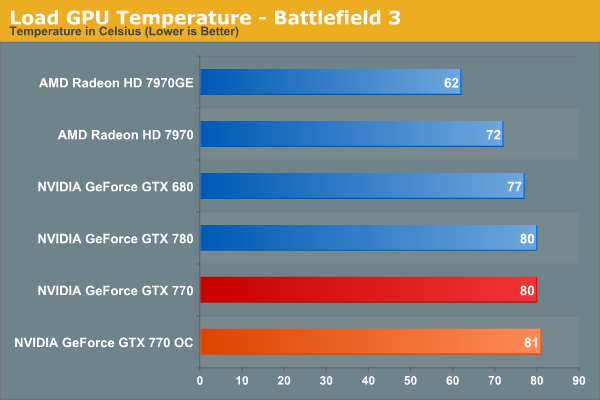
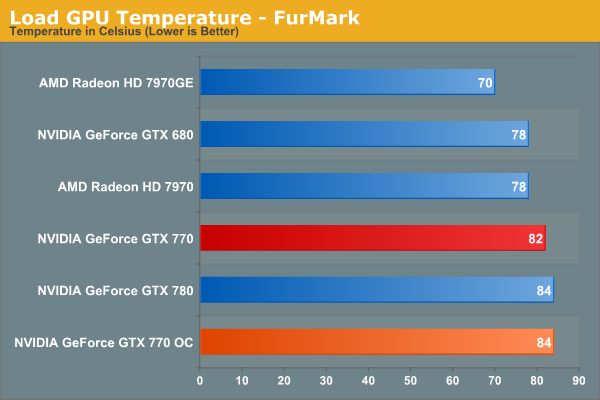
The fan curve for GTX 770 appears to be identical to that of GTX 780. Which is to say the fan significantly ramps up around 84C, keeping temperatures in the low-to-mid 80s even though GPU Boost 2.0 is allowed to go up to 95C.


Finally for fan noise, we see a small increase under Battlefield 3, and no change under FurMark. 1.5dB louder under Battlefield 3 puts noise levels on par with the GTX 780, sacrificing some of GTX 770’s abnormally quiet acoustics, but still keeping noise below the 50dB level. Or to put this another way, the performance gains for overclocking aren’t particularly high, but then again neither is the cost of overclocking in terms of noise.










117 Comments
View All Comments
LoccOtHaN - Friday, May 31, 2013 - link
True Bro ;-) AMD is more user friendly, but when Next-Gen on ATI/AMD comes PS4 and M$ XBx1 then all optimalisation will be AMD friendly and DX11.1 (DX11.x or Full DX11) and we won !whyso - Thursday, May 30, 2013 - link
Well looks like the 7970 ghz has been tied. Lower price is nice but almost no OC headroom (wouldn't be surprised if AT got a cherry picked sample) and no game bundle. Similar power consumption too. Performance increase is virtually 0 but the price decrease is nice.A5 - Thursday, May 30, 2013 - link
Worth pointing out that you can pretty easily get the AMD bundle codes for ~$30 on eBay. It wipes out the price advantage, but it does let you weigh the cards on the merits of their hardware.steve_rogers42 - Thursday, May 30, 2013 - link
Think there is an error on page 7,"Of course this is only a 9% increase in the GPU clockspeed, which is going to pale in comparison to parts like GTX 670 and GTX 780, each of which can do 20%+ due to their lower clockspeeds. So there’s some overclocking headroom in GTX 780, but as to be expected not a ton."
Last sentence should read GTX 770 yea?
Great article, good to see nvidia's progress with the GPU boost 2 and taking on-board the tdp/power issue that the 600 series seems to have had. It will be interesting to see what they make of the 760 and what it will contain.
Cheers,
nathanddrews - Thursday, May 30, 2013 - link
Wow... at worst it is equal with the 680 for $100 less. At best, it is tied with the 780 for $250 less. I think NVIDIA needs to reexamine their pricing model - I'm sure the market will fix it for them. Either the 770 is too cheap or the 780 is way too expensive. (signs point to the latter)shompa - Thursday, May 30, 2013 - link
GTX 780 die is huge. It costs Nvidia almost double to manufacture a 780GTX then a 770/680 die.Only if Nvidia have enough harvested defect dies from Tesla chips they could/would lower the price on GTX 780.
EJS1980 - Thursday, May 30, 2013 - link
If the 780 performs better than the 680 by 30-35% out the gate w/ crappy day1 drivers (future updates will only increase that advantage), how exactly is it tied with the 770?nathanddrews - Thursday, May 30, 2013 - link
How exactly is it tied? Like I said, at its best.http://www.anandtech.com/bench/Product/829?vs=827
770 and 780 tied (within +/-5%):
DiRT: Showdown - 1920x1080 - Ultra Quality + 4xMSAA
Sleeping Dogs - 1920x1080 - Ultra Quality + Normal AA
Battlefield 3 - 1920x1080 - Ultra Quality + FXAA-High
Compute: Civilization V
Compute: Sony Vegas Pro 12 Video Render
Synthetic: 3DMark Vantage Pixel Fill
EJS1980 - Thursday, May 30, 2013 - link
Your link shows the 780 with a pretty substantial performance advantage, save for a couple instances. I stand by my comment.nathanddrews - Saturday, June 1, 2013 - link
It's easy to stand by your comment if you completely ignore what I wrote and ignore the facts. For instance, the 680 was not tested with "crappy day1 drivers", it was tested with very recent 320.14 drivers while the 770/780 used 320.18. In addition, I never said that the 770 was always tied with the 780, I said "at its best", which means that at the high end it ties the 780 in some benchmarks. At its worst, on the low end, the 770 is tied with the 680 in some benchmarks. I hope that clarifies things for you.